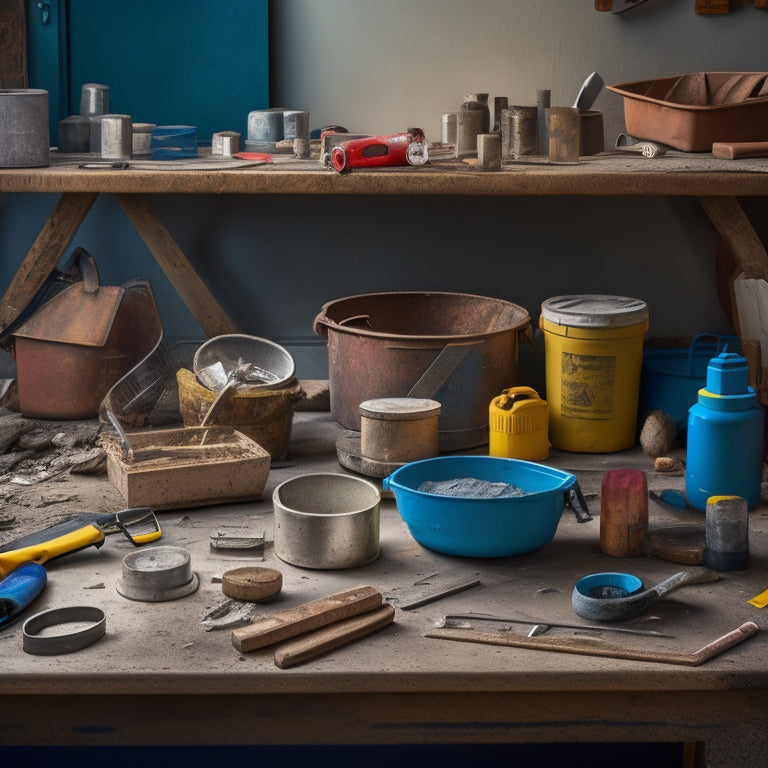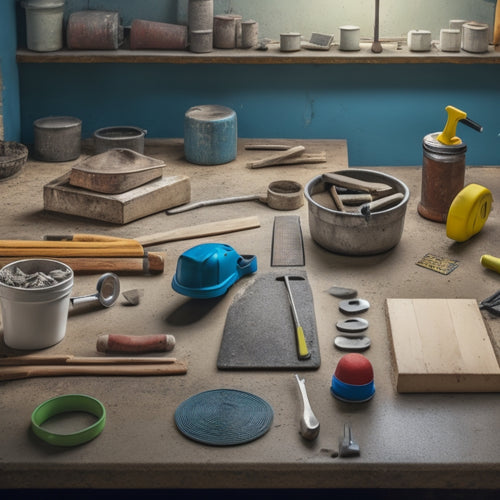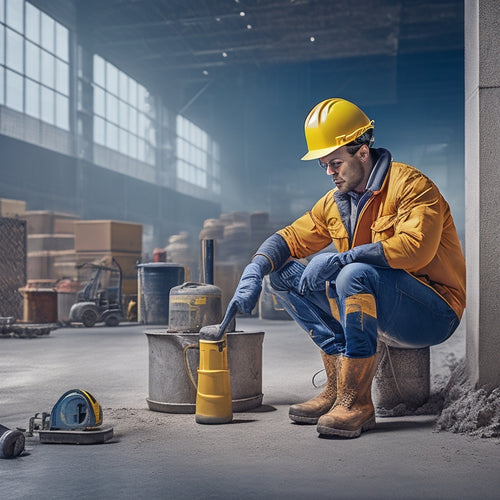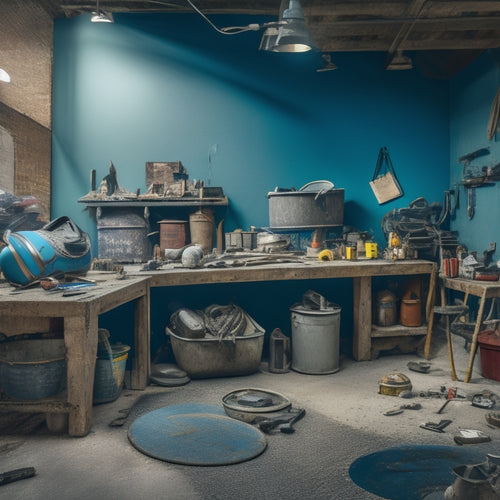
What Tools Are Needed for Concrete Repair
Share
When tackling a concrete repair project, you'll need a range of specialized tools to get the job done. Start with essential trowels for applying and smoothing repair compounds, as well as cleaning tools like wire brushes and pressure washers to prepare the surface. Mixing equipment, such as buckets and drills with mixing paddles, is also vital for compound preparation. Don't forget Safety Gear like goggles, gloves, and dust masks, as well as measurement devices like calipers and moisture meters to guarantee accurate assessments. With these tools in hand, you'll be well-equipped to tackle your concrete repair project - and discover the finer details that will take your work to the next level.
Key Takeaways
• Essential tools for concrete repair include trowels, cleaning tools, mixing equipment, cutting and shaping tools, and safety gear.
• Trowels are necessary for applying and smoothing repair compounds, with different types for various tasks such as edging and finishing.
• Cleaning tools like wire brushes, pressure washers, and sandblasters are required to prepare surfaces for repair by removing debris and dirt.
• Cutting and shaping tools like chisels, hammers, diamond blades, and concrete saws are necessary for breaking and removing concrete and making precise cuts.
• Safety gear including personal protective equipment, measurement tools, and finishing and cleanup tools are also crucial for a successful concrete repair project.
Essential Concrete Block Repair Tools
When tackling a concrete block repair project, you'll need a set of essential tools to secure a successful and lasting fix. These tools will enable you to execute advanced repair techniques that guarantee block durability.
First and foremost, you'll require a high-quality trowel for applying and smoothing out repair compounds. A level and a straightedge will help you achieve precise alignment and even surfaces. A wire brush is necessary for cleaning the repair area and removing any debris.
Additionally, a mixing bucket and a drill with a mixing paddle are essential for preparing the repair compound according to the manufacturer's instructions. You'll also need a pointing trowel for filling small gaps and a jointer or joint finishing tool for creating a smooth finish.
Finally, don't forget safety gear like gloves, safety glasses, and a dust mask to protect yourself from the materials and processes involved.
With these tools, you'll be well-equipped to execute complex repair techniques that guarantee the durability and longevity of the concrete blocks.
Cost-Effective Chisel and Hammer Options
When you're tackling concrete repair, having the right chisel and hammer can make all the difference.
You'll want to focus on hand tool essentials that provide ideal control and precision, such as a sturdy hammer with a comfortable grip and a chisel set that includes a range of widths and angles.
Hand Tool Essentials
Your concrete repair toolkit isn't complete without a reliable set of hand tools, specifically, cost-effective chisel and hammer options that can efficiently break up and remove damaged concrete. These essentials will help you tackle various tasks, from demolition to finishing touches.
To guarantee your hand tools remain in top condition, prioritize hand tool maintenance. Regularly clean and inspect your tools for signs of wear, and store them in a dry, organized space using tool storage solutions like toolboxes or pegboards. This will prevent rust and damage, extending their lifespan.
Here are some must-haves for your concrete repair hand tool arsenal:
-
A 2-3 lb. claw hammer for general-purpose demolition and fitting into tight spaces
-
A set of flat chisels (1/2', 1', and 2' wide) for breaking up and removing damaged concrete
-
A cold chisel for cutting and shaping concrete
- A pair of safety gloves and safety glasses for protecting yourself from debris and impact
Hammer Selection Guide
You'll need a reliable hammer to pair with your chisels, and selecting the right one can make all the difference in your concrete repair project's efficiency and effectiveness.
There are several hammer types to choose from, each suited for specific tasks and hammer techniques. For general concrete repair, a 2-3 pound claw hammer or a 1-2 pound ball-peen hammer is a good starting point. If you're working with thicker concrete or need more force, consider a 4-6 pound sledgehammer.
When it comes to hammer techniques, it's crucial to master the proper grip, stance, and striking motion to avoid fatigue and injury. A comfortable, balanced grip and a smooth, controlled swing will help you generate more power and precision.
Additionally, practice different striking techniques, such as the 'push-pull' method, to optimize your hammer's performance.
Chisel Set Options
What makes a chisel set cost-effective is the combination of versatility, durability, and performance it offers, allowing you to tackle various concrete repair tasks with a single, well-curated set.
When selecting a chisel set, reflect on the types of chisels you'll need for your projects. A basic set should include flat, pointed, and round chisels, as well as a bolster and a pitching chisel.
Here are some key factors to keep in mind when choosing a cost-effective chisel set:
-
Chisel types: Verify your set includes a variety of chisel types to tackle different tasks, such as breaking, prying, and scraping.
-
Chisel maintenance: Look for chisels with durable, rust-resistant coatings and think about sets with carrying cases or storage options to keep your tools organized and protected.
-
Ergonomics: Opt for chisels with comfortable, ergonomic handles that reduce fatigue and improve control.
- Material quality: Choose chisels made from high-quality, heat-treated steel that can withstand heavy use and maintain their edge.
Must-Have Mixing and Pouring Equipment
When it comes to concrete repair, you'll need the right mixing and pouring equipment to guarantee a successful outcome.
You'll want to evaluate the mixing drum capacity that suits your project's specific requirements, as this will directly impact the quality of the concrete mix.
Mixing Drum Capacity
With a clear understanding of the importance of mixing and pouring equipment in concrete repair, selecting a mixing drum with the right capacity is essential to achieving consistent, high-quality results.
You'll want to take into account the size of your project and the type of repair you're doing to determine the ideal drum capacity. A drum that's too small can lead to inadequate mixing, while one that's too large can be inefficient and wasteful.
When choosing a mixing drum, keep the following factors in mind:
-
Drum size: Confirm the drum can hold the entire batch of mixed concrete, with some extra room for mixing and scraping the sides.
-
Mixing techniques: Reflect on the type of mixing you'll be doing, such as paddle mixing or drum mixing, and choose a drum that accommodates your technique.
-
Drum maintenance: Select a drum that's easy to clean and maintain to prevent contamination and guarantee consistent results.
- Material compatibility: Verify the drum is compatible with the type of concrete and additives you'll be using to prevent damage or contamination.
Pouring Equipment Options
You'll need pouring equipment that's just as reliable as your mixing drum to guarantee a smooth, efficient concrete repair process.
When it comes to pouring equipment, you have several options to choose from, depending on the specific requirements of your project. For instance, a concrete pump is ideal for large-scale projects that require a high volume of concrete to be poured quickly and efficiently. On the other hand, a wheelbarrow or bucket may suffice for smaller projects.
Regardless of the equipment you choose, it's vital to master various pouring techniques to achieve a smooth, even finish. This includes maintaining a consistent flow rate, using the right pouring height, and minimizing segregation.
Regular equipment maintenance is also important to prevent clogs, assure proper flow, and extend the lifespan of your pouring equipment.
High-Quality Trowels for Smooth Finishes
Achieving a smooth finish in concrete repair requires selecting a high-quality trowel that can effectively spread and level the material.
You'll want to choose a trowel that suits your specific repair needs, considering factors like the type of concrete, the size of the area, and the desired finish.
When it comes to trowel types, you'll find options like:
-
Finishing trowels: Ideal for creating a smooth, even surface, these trowels typically have a flat, rectangular blade and a comfortable grip.
-
Notched trowels: Featuring a series of notches or grooves, these trowels are perfect for applying and spreading material evenly.
-
Pooling trowels: Designed for large areas, pooling trowels have a longer handle and a larger blade, making them ideal for spreading material quickly.
- Edging trowels: With a curved or angled blade, edging trowels are perfect for getting into tight spaces and creating clean, defined edges.
Reliable Drill and Bit Combinations
Selecting the right drill and bit combination is essential to efficiently mixing and applying concrete repair materials, especially after you've prepared the surface with a high-quality trowel.
You'll need a drill that can handle the demands of mixing and applying concrete, which often requires high torque and speed. Cordless drills are popular for their convenience, but corded drills provide more consistent power.
When it comes to bit materials, you'll want to choose bits made from high-speed steel (HSS) or tungsten carbide (TC) for their durability and resistance to wear.
For mixing concrete, you'll need a paddle bit or a mixing paddle attachment. These bits are designed to handle the thick, heavy mixture of concrete and can withstand the high torque required to mix it.
For applying concrete, a drill bit with a countersink or a masonry bit is ideal. These bits are designed to create a smooth, even surface and can be used to drill into concrete, brick, or block.
Specialized Concrete Cutting Tools Needed
When tackling concrete repair projects, concrete cutting tools, such as diamond blades and concrete saws, become essential for making precise cuts and removing damaged areas.
These specialized tools enable you to execute complex concrete cutting methods and advanced cutting techniques with ease. With the right cutting tools, you can confidently tackle projects that require intricate cuts, removal of damaged concrete, or demolition of entire structures.
Some of the most critical concrete cutting tools you'll need include:
-
Diamond blades: ideal for making precise cuts in concrete, asphalt, and other hard materials
-
Concrete saws: designed for heavy-duty cutting and demolition tasks
-
Rotary hammers: perfect for drilling and chiseling concrete
- Reciprocating saws: great for making curved cuts and demo work in tight spaces
Vital Safety Gear and Accessories
You'll need to pair your concrete cutting tools with crucial safety gear and accessories to protect yourself from the hazards associated with cutting, drilling, and demolishing concrete.
One of the most critical components is safety goggles, which shield your eyes from flying debris and particulate matter. Make sure to choose goggles with anti-fog coatings and good optical clarity to guarantee you can see clearly while working.
Another essential piece of safety equipment is protective gloves. These gloves should provide grip, dexterity, and puncture resistance to prevent injuries from sharp edges or rough surfaces. Look for gloves made from durable materials like Kevlar, synthetic fibers, or leather that can withstand the rigors of concrete repair work.
Additionally, consider investing in a dust mask or respirator to prevent inhaling concrete dust and silica particles, which can cause respiratory problems.
Measuring and Testing Device Essentials
Your concrete repair toolkit isn't complete without accurate measuring and testing devices that help you diagnose issues, assess damage, and monitor progress.
These devices enable you to employ precise measuring techniques and testing methods to identify the root cause of the problem and develop an effective repair strategy.
Some essential measuring and testing devices to include in your toolkit are:
-
Digital calipers: for accurate measurements of cracks, joints, and surface irregularities
-
Moisture meters: to detect and measure moisture levels in the concrete
-
Concrete test hammers: to assess the surface hardness and detect internal defects
- Thermocouples: to measure temperature differences and detect heat-related damage
Efficient Cleaning and Finishing Tools
After diagnosing the issue and developing a repair strategy, you're ready to tackle the concrete surface, and that's where efficient cleaning and finishing tools come into play. These tools are essential in preparing the surface for repair and ensuring a strong bond between the old and new concrete.
You'll need a variety of cleaning techniques to remove dirt, oil, and other substances that can compromise the repair. A pressure washer is ideal for removing loose debris, while a wire brush or scrubber can be used to remove stubborn stains. For more aggressive cleaning, a sandblaster or grinder may be necessary.
Once the surface is clean, it's time to focus on finishing methods. A trowel or float can be used to smooth out the surface, while a finishing broom or texture mat can be used to achieve the desired texture. Depending on the specific repair, you may also need specialized tools like a concrete edger or joint cutter.
Frequently Asked Questions
Can I Use a Regular Drill for Concrete Repair Projects?
When tackling concrete repair projects, you'll want to think twice before reaching for your regular drill.
While it might seem like a convenient option, it's not the best choice.
You'll need drill types specifically designed for concrete, such as hammer drills or rotary hammers, which provide the necessary torque and impact to penetrate the hard surface.
Alternative tools, like chiseling guns or demo hammers, might also be necessary for more extensive repairs.
How Do I Prevent Damage to Surrounding Concrete During Repair?
You're likely aware that 75% of concrete repair projects fail due to inadequate surface preparation.
To prevent damage to surrounding concrete, you'll need to focus on surrounding protection techniques.
Before starting the repair, prepare the area by thoroughly cleaning it and applying a bonding agent to guarantee a strong bond between old and new concrete.
Use a barrier, such as plastic sheets or tape, to contain the repair area and prevent damage from spills or over-spray.
What Safety Gear Is Required for Working With Epoxy-Based Products?
When working with epoxy-based products, you'll need to prioritize epoxy safety by wearing the right protective equipment.
You should don gloves, safety glasses, and a face mask to prevent skin and eye irritation, as well as inhalation of fumes. A respirator may also be necessary, depending on the product and ventilation.
Make certain you have a first aid kit on hand and follow the manufacturer's safety guidelines to minimize risks.
Can I Mix and Apply Concrete in Cold Weather Conditions?
When you're working with concrete in cold weather conditions, you'll need to employ specialized techniques to guarantee proper curing.
You can't just mix and apply concrete as you'd in warmer temperatures. Instead, you'll need to use cold weather techniques, such as accelerating the set time or using insulated blankets, to promote concrete curing methods that can withstand the chill.
How Long Does It Take for Newly Poured Concrete to Fully Cure?
You're probably aware that the Great Pyramid of Giza, built with limestone and concrete, has withstood the test of time for over 4,500 years.
Now, when you pour new concrete, you're likely wondering how long it takes to fully cure.
The curing process typically takes around 28 days, during which time the concrete strength increases rapidly.
Conclusion
You've got the skills, now get the tools. Concrete repair isn't a DIY project for the faint of heart, but with the right equipment, you'll be a pro in no time.
On one hand, you're faced with crumbling infrastructure and hazardous cracks, but on the other, you have the power to transform it into a solid, safe, and durable structure.
With these must-have tools, you'll bridge the gap between damage and durability.
Related Posts
-

Must-Have Tools for Laying Concrete Tiles
When laying concrete tiles, you'll need a range of essential tools to get the job done right. Start with subfloor pre...
-

10 Best Tools for Sealed Concrete Flooring on Budget
When starting on a sealed concrete flooring project on a budget, you'll need to prioritize essential tools without sa...
-

What Tools Do You Need for Concrete Flooring
You'll need a thorough arsenal of specialized tools to achieve a high-quality, professional-looking concrete floor, i...


